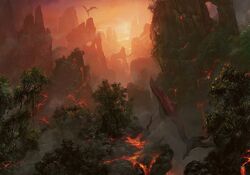No edit summary |
|||
| Line 80: | Line 80: | ||
* <c>Tukatongue Thallid</c> |
* <c>Tukatongue Thallid</c> |
||
* <c>Unstable Frontier</c> |
* <c>Unstable Frontier</c> |
||
| + | * {{card|Yurlok of the Burn-Thrash||CMR}} |
||
* <c>Zombie Outlander</c> |
* <c>Zombie Outlander</c> |
||
}} |
}} |
||
Revision as of 14:53, 28 October 2020
| Jund | |
|---|---|
| General Information | |
| First seen | Shards of Alara |
| Last seen | Conflux |
| Status | Merged with the other Shards |
| Game Information | |
| Colors |
|
| Mechanics | Devour |
Jund is one of five shards of Alara. It is primarily red-aligned, with black and green as secondary colors.[1][2][3]
Description
Jund is comprised of active volcanoes, sharp mountain ledges, and lush jungles. It has a pungent sulfuric atmosphere. The hot climate, bubbling tar-baths, and volcanic activity combine with the reptilian populace to create a sense of a primeval world. The land has deep-cut valleys in it that resemble huge claw marks if seen from above. These deep gashes in the land are where the jungles and swamps are found, The active volcanoes add difficulty to the lives of its human, viashino and goblin inhabitants, but are of great advantage to the dragons that dominate it.[4][5]
According to the creatures and shamans of Jund, Jund is a world of pure freedom. Every animal can do whatever they want to do. There is no authority of Jund, and therefore the world has become crazy and wild. Since Jund lacks white and blue mana, there is no peace and thought. Instinct is the choice over control and deliberation.
The food chain
Life on Jund is a never-ending struggle of survival of the fittest.[6] It is a voracious, creature-eat-creature world - almost every living thing on the plane is both predator and prey at once, constantly on the lookout for the bloody fare while trying to avoid becoming someone else's. The dragons are at the top of the food chain and feed on everything and anything below them. Fiercely territorial, they will fight over any scrap of food taken from their territory. When a dragon becomes too ancient to protect their territory, they perform a ritual called the Shriek of Flame where they plunge themselves directly into an active volcano, causing that volcano to erupt- often eradicating much of the prey left in its territory.
Second on the pecking order are the Crocodile-like Viashino. Stronger than the other humanoid races, Viashino are able to occupy the deep jungles and swamps where the hunting is harder for Dragons. They are muscular brutes that form tribes called Thrashes.
Humans are next on the food chain. They form nomadic tribes that are necessary for survival. Humans live in the small jungles at the base of mountains and in the scarred volcanic flats. At the age of ten, humans undergo a dangerous rite of passage where the warriors will climb an active volcano and are forced to bring back a glass shard to become a warrior. Shamans take a dangerous drug called Dreamfire Draught which attracts elemental entities. The young shaman must bargain with the elemental for a cure to this poison to become a Shaman. With either test, failure results in death. The humans have developed reptilian features such as forked tongues and scales covering some of their skin. In battle, a human warrior will mark a victory by weaving part of their hair into a small braid and binding it with a piece of their enemy's flesh.
The rat-like Goblins are last on the food chain, and are so used to being devoured by dragons, that their culture has become one glorifies that death and recognizes itself as "divine-food". Goblins inhabit the highest regions of the mountains which are easy prey for young dragons.
Conflux
When the Conflux occurred, blue and white mana flooded into Jund. The food chain became disrupted and fell apart. Creatures became less violent and more thoughtful, but this created more wildness. The angry shamans struggled to keep control as the dragons flew to new lands to destroy more. New creatures and plants emerged, and the natural instinct of several of Jund's creatures disappeared. As Jund edges merge more and more with the other shards, it becomes part of the new Alara.[7]
Notable locations
- The Bloodhall is the ancient meeting place of the humans of Jund from all clans.
- Varakna is the deepest tar-swamp in Jund.
- The Worldheart Chalice, the lair of Nicol Bolas.
- The Pit, the deepest valley in the land, over two miles deep.
- Hellkite's Pass [8]
Planeswalker visitors
In-game references
- Represented in:
- Associated cards:
- Quoted or referred to:
- Algae Gharial
- Bloodpyre Elemental
- Canyon Minotaur (Conflux)
- Charnelhoard Wurm
- Corrupted Roots
- Drag Down
- Dragonsoul Knight
- Esper Stormblade
- Fiery Fall (Conflux)
- Flameblast Dragon (Conflux)
- Gluttonous Slime
- Goblin Mountaineer (Shards of Alara)
- Magma Spray (Shards of Alara)
- Mycoid Shepherd (Alara Reborn)
- Ooze Garden
- Rhox Brute
- Rockslide Elemental
- Savage Lands
- Scarland Thrinax
- Scourge of Nel Toth
- Spellbound Dragon
- Spore Burst
- Sprouting Thrinax
- Talon Trooper
- Toxic Iguanar
- Tukatongue Thallid
- Unstable Frontier
- Yurlok of the Burn-Thrash
- Zombie Outlander
References
- ↑ Magic Arcana (August 15, 2008). "Shard Preview: Jund". magicthegathering.com. Wizards of the Coast.
- ↑ Mark Rosewater (December 01, 2008). "Following Your Heart". magicthegathering.com. Wizards of the Coast.
- ↑ Mike Flores (September 11, 2008). "Echinacea, Incorporated". magicthegathering.com. Wizards of the Coast.
- ↑ Doug Beyer (December 3, 2008). "Jund's One Rule". magicthegathering.com. Wizards of the Coast.
- ↑ Magic Arcana (December 04, 2008). "Jund Style Guide". magicthegathering.com. Wizards of the Coast.
- ↑ Expressed through the devour mechanic. Mark Rosewater (September 15, 2008). "Shard Candy". magicthegathering.com. Wizards of the Coast.
- ↑ Michael Yichao (November 4, 2015). "All the Cairns of Jund". magicthegathering.com. Wizards of the Coast.
- ↑ Flavor text for Sigil Captain
External links
- Magic Arcana (May 21, 2009). "The Style of Jund". magicthegathering.com. Wizards of the Coast.


